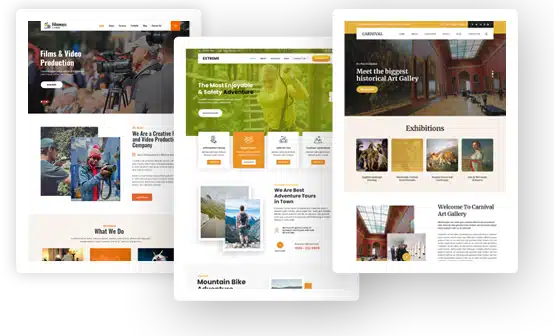How to Increase User Engagement on Your WordPress Site
Nowadays, when the digital world is so present in our lives, in almost all fields, it is essential to be present on the Internet. However, it is still often debated whether every business must have a website.
Yet, the discussion does not end there. Some marketers claim it is enough just to have a website for your business, others say engagement on your website dictates the quality of traffic and therefore increases the conversion rate.
In this article, we will talk about all the ways to increase audience engagement on your website, and we will also mention alternative methods and tools that can help us to better connect with our audience.
But before we go too deep, let’s first define what user engagement is.

What Is User Engagement?
Marketers and business owners have used the word “engagement” so often lately, that it has become a buzzword, and in that way, it has lost its meaning. But even if “user engagement” has become a cliche, it’s still an important factor for you to consider in building your online presence.
In the simplest terms, user engagement is how users interact with the content on your site.
User engagement describes how frequently and for how long users access your website or application and engage with it. A company may measure user engagement by tracking the movement of visitors, the length of time they spend on certain pages, and user interaction (clicks and downloads), as well as sharing.
Companies improve user engagement to make the website more attractive to customers, in the hopes of increasing conversion rates.
Types of User Engagement
In the traditional business model, there are four ways to engage customers. Let’s see what those ways are.
Contextual Engagement
Contextual engagement is based on customer behavior. This type of engagement helps marketers better understand how the target audience functions and behaves. In this way, they can gather various data about the majority of their audience and tailor their website to them accordingly. You can use a product recommendation quiz to learn users’ preferences, personalize their experience, and boost overall engagement.
For example, if a consumer browses a few things on your eCommerce site without adding anything to their basket, you may send them a customized email with products based on their search history to nudge them into taking action.
Engagement of Convenience
Convenience engagement is any type of brand-customer interaction that improves the customer’s convenience. The Amazon Dash Button is an example of the engagement of convenience.
Dash Button is a tiny wireless gadget that is comparable in size to a gum pack. When you hit the button, the gadget immediately orders the Amazon products you’ve chosen over Wi-Fi and Amazon delivers them directly to you. Consumers find this button convenient because it helps them to save time while obtaining household items.

Emotional Engagement
A study finds that 99% of purchasing behavior decisions are based on the emotional engagement of the customer. Human psychology factors, such as a preferred color, sentence form, communication style, design, and brand are just some of the many things that can make a user relate to a product owner or service provider and buy the product or service after all.
Social Engagement
Some products are simply more suitable for social networks and, therefore, will have more success on those platforms. That does not mean that you should neglect the content on your website – you just need to create posters that will attract your audience to share them on social networks.
Social media is a perfect tool for increasing user engagement, in general. However, when it comes to social media, everything starts with building a relationship with customers.
You can do that by always responding quickly to your customers, encouraging them to share their stories, organizing giveaways and contests, and responding to all online customer reviews.

How to Increase User Engagement
Okay, now that we know what user engagement is and what types of user engagement there are, let’s see how we can increase engagement.
Don’t Let Your Page Load Too Slowly
This is a crucial but often neglected point. Just remember how you feel and what you do when you enter a page that loads very slowly, and it has nothing to do with the Internet but only with the page speed.
You get angry, curse the existence of the site, and close the page before it finishes loading, right? Well, so will your users if you allow your page to load slowly. That brings us to the conclusion that to avoid problems with site speed, we should check our website speed regularly.
We can do that by using an advanced tool like Google PageSpeed Insights.
Create Useful Content for Your Users
You may find that creating useful content can be the most challenging task, as it requires a good understanding of your target audience and what would trigger them to continue reading, to comment, or to share your content.
On the other hand, making content useful is the key to any kind of website.
And what do we mean by useful content? It can include content your audience and potential customers want but also content that can help your business meet its goals. However, they don’t always align.
A piece of content can increase user engagement as it is beneficial to them but that doesn’t guarantee that it will help your business meet conversion goals and vice versa. However, without valuable and engaging content, users don’t stay too long on the website. They don’t engage with your content, and, in the end, the chance of them buying your product decreases.
As you can see, everything is connected.
Build a Chat Box on the Homepage
A chat box is another great way to connect with your users and make them feel that you are easily accessible—that they can contact you at any time. What makes chat boxes different from email communication is that you can interact with users in real time.
By building a chat box, you are building an instant tool for user engagement. Remember to use a profile a picture and a name that makes users feel like they’re talking to a person and not a robot.
If you want to stand behind a logo, you can hire a web designer to create one that aligns with the brand you want to build. Or, you could use a logo maker to help you do this on your own—or at least to get an idea of how you want it to look.

Direct Users to Other Content on Your Site
This is the perfect way to keep users on your site for longer. How exactly does it work?
Let’s say you have a blog section on your website, and now one of the users googled something, and one of your posts came up among the first results.
They went to your blog post and, within the first few seconds, saw that it gave them the answer they came for. They continue to read and, at some point, begin to think “That’s it. I got the answer, I’m moving on.”
In a normal situation, the user simply leaves the page and probably never returns to your site. However, if within your blog post there were a link that led to another blog post that would be of interest to the user, then there is a much higher chance that they will click on that link and continue reading the content on your site.

The two blog posts should be at least somehow connected. However, it doesn’t have to be another blog post. It can be a page where the user can learn more about your product.
If you intrigue them with valuable content and offer them what they want to buy, they may decide to buy it right away.
Conclusion
User engagement is crucial for creating a highly effective WordPress website that benefits your brand. The only way to outperform your rivals is by focusing on what customers want and meeting their needs.
Some content may aim to increase engagement, some to reach conversion goals, but when we do the math, it’s all about building and maintaining relationships with potential and current customers.
Nina Petrov Author
Nina Petrov is a content marketing specialist, passionate about graphic design, content marketing, and the new generation of green and social businesses. She starts the day scrolling her digest on new digital trends while sipping a cup of coffee with milk and sugar. Her white little bunny tends to reply to your emails when she is on vacation. https://www.linkedin.com/in/nina-petrov/

